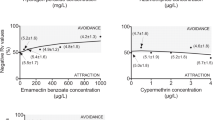Abstract
The polychaete Nereis virens occurs commonly in marine sediments, is widely distributed, and is a popular bait species, as well as a potential replacement for wild-caught fish in commercial fish feed preparations. It is being considered as a potential co-extractive species for culture in integrated multi-trophic aquaculture operations. However, it is not known whether pesticides or drugs used to treat sea lice on farmed salmon, such as emamectin benzoate (EB), would adversely affect cultured or wild worms, because these compounds may persist in the environment. To determine the potential effects of EB to N. virens, bioassays were performed wherein worms were exposed in sand for 30 days to a concentration of 400 µg/kg dw (nominal). While no treatment-related mortality occurred, significant decreases in worm mass and marked behavioral changes (lack of burrowing) were observed in EB-treated sand compared with controls. These lab-based observations suggest a potential hazard to worms at sites where EB treatments have occurred.



Similar content being viewed by others
References
Barrington K, Chopin T, Robinson S (2009) Integrated multi-trophic aquaculture (IMTA) in marine temperate waters. FAO Fish Aquac Tech Pap 529:7–46
Benskin JP, Ikonomou MG, Surridge BD, Dubetz C, Klaassen E (2016) Biodegradation potential of aquaculture chemotherapeutants in marine sediments. Aquac Res 47:482–497
Burridge LE, Hamilton N, Waddy SL, Haya K, Mercer SM, Greenhalgh R (2004) Acute toxicity of emamectin benzoate (SLICE™) in fish feed to American lobster, Homarus americanus. Aquac Res 35:713–722
Burridge LE, Weis JS, Cabello F, Pizarro J, Bostick K (2010) Chemical use in salmon aquaculture: a review of current practices and environmental effects. Aquaculture 306:7–23
Government of New Brunswick (GNB) (2010) New Brunswick finfish aquaculture development strategy 2010–2014
Hargrave BT (ed) (1994) Modeling benthic impacts of organic enrichment from marine aquaculture. Canadian technical report of fisheries and aquatic sciences 1949, p xi + 125
Haya K, Burridge LE, Davies IM, Ervik A (2005) A review and assessment of environmental risk of chemicals used for the treatment of sea lice infestations of cultured salmon. In: Hargrave B (ed) Handbook of environmental chemistry, vol 5. Water Pollut M, pp 305–341
Kristensen E (2000) Organic matter diagenesis at the oxic/anoxic interface in costal marine sediments, with emphasis on the role of burrowing animals. Hydrobiologia 426:1–24
Kuo J, Buday C, van Aggelen G, Ikonomou MG, Pasternak J (2010) Acute toxicity of emamectin benzoate and its desmethyl metabolite to Eohaustorius estuarius. Environ Toxicol Chem 29(8):1816–1820
Mayor DJ, Solan M, Martinez I, Murray L, McMillian H, Paton GI, Killham K (2008) Acute toxicity of some treatments commonly used by the salmonid aquaculture industry to Corophium volutator and Hediste diversicolor: whole sediment bioassay tests. Aquaculture 285:102–108
Miron G, Brock V, Kristensen E (1994) Effects of mercury on the ventilation behaviour of the polychaete Nereis virens (Sars). J Exp Mar Biol Ecol 18:67–81
Olive PJW (1999) Polychaete aquaculture and polychaete science: a mutual synergism. Hydrobiologia 402:175–183
Olla BL, Bejda AJ, Studholme AL, Pearson WH (1984) Sublethal effects of oiled sediment on the sand worm Nereis (Neanthes) virens: induced changes in burrowing and emergence. Environ Res 13:121–139
Papaspyrou S, Gregersen T, Kristensen E, Christensen B, Cox RP (2006) Microbial reaction rates and bacterial communities in sediment surrounding burrows of two nereidid polychaetes (Nereis diversicolor and N. virens). Mar Biol 148:541–550
Pinfold G (2013) Socio-economic impact of aquaculture in Canada. Fisheries and Oceans Canada Aquaculture Management Directorate
Piot A, Rochon A, Stora G, Desrosiers G (2008) Experimental study on the influence of bioturbation performed by Nephtys caeca (Fabricius) and Nereis virens (Sars) annelidae on the distribution of dinoflagellate cysts in the sediment. J Exp Mar Biol Ecol 369:92–101
Roth M, Richards RH, Sommerville C (1993) Current practices in the chemotherapeutic control of sea lice infestations in aquaculture: a review. J Fish Dis 16:1–26
Schreck CB, Moyle PB (eds) (1990) Methods for fish biology. American Fisheries Society, Bethesda, p 684
Tauber R, Gillan N, Crouch L, Greenhalgh R (2006) Liquid chromatography/fluorescence method for emamectin B1a and desmethylamino-emamectin B1a residues in lobster tissue. J AOAC Int 89:1672–1676
Telfer TC, Baird DJ, McHenery JG, Stone J, Sutherland I, Wislocki P (2006) Environmental effects of the anti-sea lice (copepoda: Caligidae) therapeutant emamectin benzoate under commercial use conditions in the marine environment. Aquaculture 260:163–180
Tucca F, Moya H, Pozo K, Borghini F, Focardi S, Barra R (2016) Occurrence of antiparasitic pesticides in sediments near salmon farms in the northern Chilean Patagonia. Mar Pollut Bull 115:465–468
Van de Riet JM, Brothers NN, Pearce JN, Burns BG (2001) Simultaneous determination of emamectin and ivermectin residues in Atlantic salmon muscle by liquid chromatography with fluorescence detection. J AOAC Int 84(5):1358–1362
Van Geest JL, Burridge LE, Kidd KA (2014) The toxicity of the anti-sea lice pesticide AlphaMax® to the polychaete worm, Nereis virens. Aquaculture 430:98–106
Acknowledgements
The authors thank the St. Andrews Biological Station and the Canadian Rivers Institute for technical assistance and laboratory supplies and Cooke Aquaculture Inc. for their donation of analytical chemicals.
Funding
Funding for this work was provided by the Natural Sciences and Engineering Research Council of Canada Integrated Multi-Trophic Aquaculture program through the University of New Brunswick Saint John. Special thanks to the following staff of the St. Andrews Biological Station, the Canadian Rivers Institute, Gregor Reid, Kenneth MacKeigan, Monica Lyons, David Wong, Craig Smith, Terralynn Lander, and especially Jim, Tina, and Becky McBriarty.
Author information
Authors and Affiliations
Corresponding author
Rights and permissions
About this article
Cite this article
McBriarty, G.J., Kidd, K.A. & Burridge, L.E. Short-Term Effects of the Anti-sea Lice Therapeutant Emamectin Benzoate on Clam Worms (Nereis virens). Arch Environ Contam Toxicol 74, 539–545 (2018). https://doi.org/10.1007/s00244-017-0461-2
Received:
Accepted:
Published:
Issue Date:
DOI: https://doi.org/10.1007/s00244-017-0461-2




